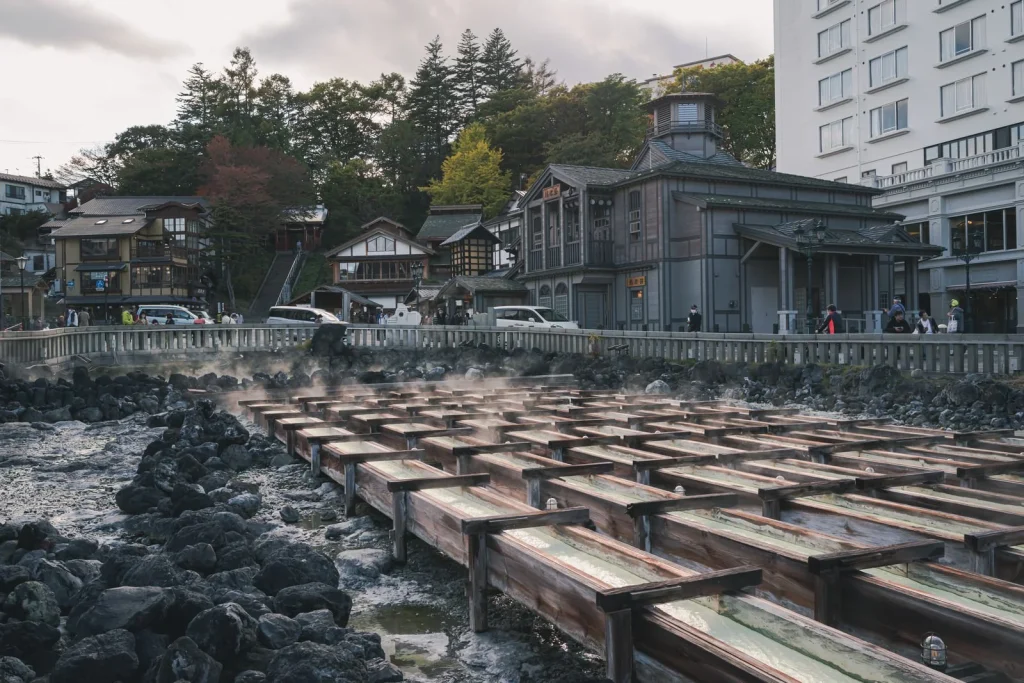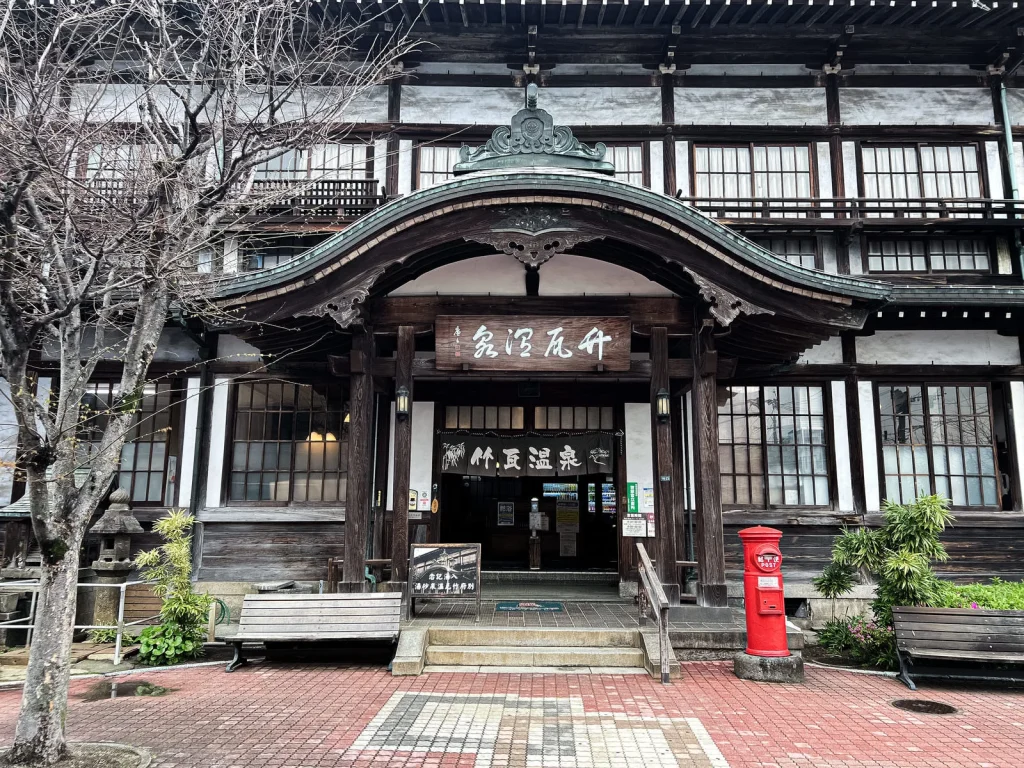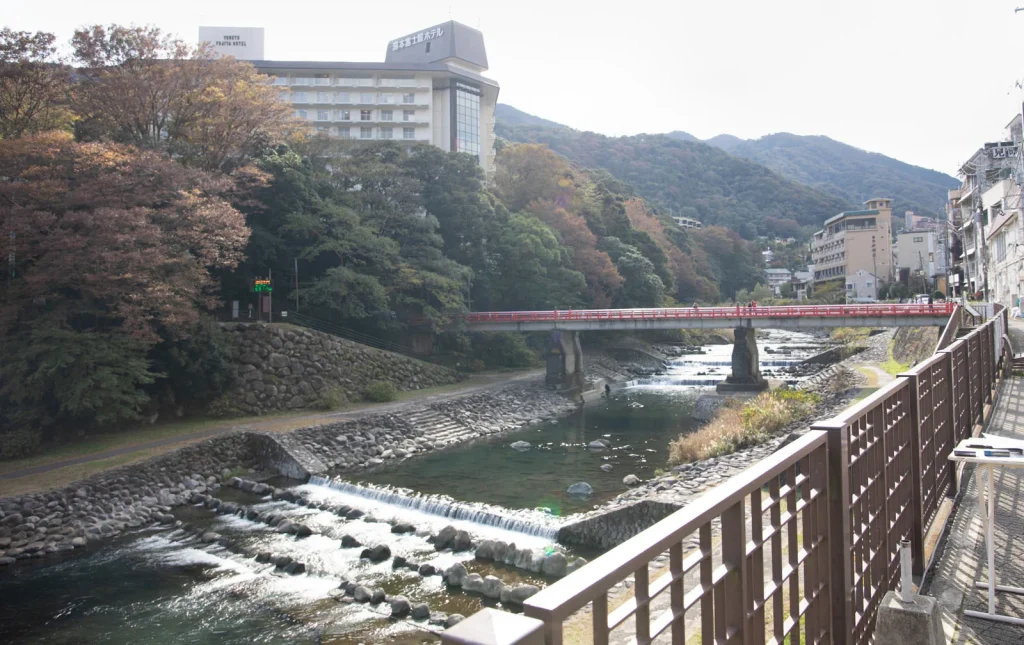Nestled amidst the breathtaking landscapes of Japan lies a treasure trove of natural wonders that beckons travelers seeking solace and relaxation — the enchanting world of Japanese hot springs.
From the serene mountainous regions to the coastal paradises, each hot spring, or “onsen,” offers a unique blend of cultural richness and therapeutic warmth, creating an immersive experience that transcends the ordinary.
Join us as we embark on a journey into the heart of Japan’s hot spring culture, exploring the diverse landscapes and age-old traditions that make these thermal retreats a timeless attraction.
Exploring the Rich Tapestry of Japan’s Hot Springs:
Types and Characteristics:
Japan’s hot springs come in a variety of types, each boasting distinct mineral compositions and therapeutic benefits.
From sulfuric springs renowned for their skin-enhancing properties to alkaline springs promoting relaxation, the onsen experience is as diverse as the country itself.
Whether it’s the sulfuric baths of Hakone or the alkaline-rich waters of Kinosaki Onsen, every onsen tells a unique tale of nature’s healing touch.
Popular Hot Spring Destinations
Kusatsu (草津)

Location:
Nestled high in the mountains of Gunma Prefecture, Kusatsu Onsen emerges as a hidden gem among Japan’s renowned hot spring destinations.
Surrounded by lush greenery and pristine landscapes, Kusatsu offers a serene escape from the hustle and bustle of urban life.
Access from Tokyo:
Despite its mountainous location, Kusatsu Onsen is surprisingly accessible from Tokyo.
Travelers can take a direct bus from Tokyo Station or use the efficient JR Rail system to reach Naganohara-Kusatsuguchi Station.
From there, a scenic bus ride through the mountains brings you to Kusatsu in approximately 25 minutes.
Distinctive Features:
Kusatsu Onsen stands out for its unique characteristics, creating a distinctive charm that captivates visitors.
The Yubatake, or hot water field, is a symbol of the town, where steaming hot water is cooled to separate sulfur, creating an iconic sight.
The charming Yumomi performance, a traditional method of cooling the hot spring water to a suitable bathing temperature, is another cultural highlight not to be missed.
Therapeutic Efficacy:
The hot spring waters of Kusatsu are celebrated for their therapeutic benefits.
Rich in sulfuric content, these healing waters are believed to alleviate various ailments, including joint pain, skin conditions, and fatigue.
Visitors can immerse themselves in the rejuvenating effects of the Yubatake’s waters, experiencing both physical and mental relaxation.
Beppu (別府)

Location:
Nestled along the picturesque coastline of Oita Prefecture on the island of Kyushu, Beppu Onsen emerges as a captivating jewel among Japan’s renowned hot spring destinations.
Surrounded by rolling hills and the soothing embrace of the Seto Inland Sea, Beppu beckons travelers with its geothermal wonders and therapeutic waters.
Access from Tokyo:
While Beppu is situated on the island of Kyushu, accessing this geothermal oasis from Tokyo is a seamless journey.
Travelers can opt for a convenient and swift flight to Oita Airport, followed by a scenic train ride to Beppu Station.
Alternatively, a Shinkansen (bullet train) journey to Kokura Station in Fukuoka and a subsequent transfer to the Sonic Limited Express brings you to Beppu in a matter of hours.
Distinctive Features:
Beppu Onsen distinguishes itself with a diverse array of hot spring experiences.
The city is home to the “Beppu Hatto,” consisting of eight distinct hot spring areas, each with its unique charm.
Visitors can explore Umi Jigoku (Sea Hell), where cobalt-blue waters contrast with vibrant botanical gardens, or immerse themselves in the mud baths of Oniyama Jigoku.
The juxtaposition of traditional ryokans and modern resorts adds to the eclectic charm of Beppu.
Therapeutic Efficacy:
The hot spring waters of Beppu are celebrated not only for their relaxation-inducing qualities but also for their therapeutic benefits.
With a variety of mineral compositions, the onsens here are believed to address a spectrum of ailments, including rheumatism, skin conditions, and stress.
Beppu’s diverse hot spring options cater to those seeking both physical and mental rejuvenation.
Kinosaki(城崎)
Location:
Nestled along the scenic coast of the Sea of Japan in Hyogo Prefecture, Kinosaki Onsen emerges as a timeless retreat, renowned for its historic charm and soothing hot springs.
Surrounded by a blend of traditional architecture and the picturesque Maruyama River, Kinosaki captivates visitors with its serene ambiance.
Access from Tokyo:
Despite its coastal location, Kinosaki Onsen is easily accessible from Tokyo, offering a unique journey through Japan’s diverse landscapes.
Travelers can take a Shinkansen (bullet train) from Tokyo to Osaka and then transfer to the Limited Express Konotori, bringing them to Kinosaki Onsen in approximately four hours.
Alternatively, direct trains are available from Osaka to Kinosaki, making the journey convenient and enjoyable.
Distinctive Features:
Kinosaki Onsen distinguishes itself with a unique blend of traditional Japanese architecture and a unique public bathhouse culture.
The town is renowned for its seven public bathhouses, or “soto-yu,” each with its own character and charm.
Visitors can stroll through the charming streets adorned with willow trees while wearing traditional yukata and geta, enhancing the nostalgic atmosphere.
Therapeutic Efficacy:
The hot spring waters of Kinosaki are rich in minerals, believed to have various health benefits.
Bathing in these soothing waters is said to alleviate fatigue, promote skin health, and provide relaxation for both the body and mind.
The practice of “soto-yu meguri” or public bathhouse hopping is not only a cultural experience but also a therapeutic journey.
Noboribetsu (登別)
Location:
Nestled in the picturesque mountains of Hokkaido, Noboribetsu Onsen stands as a testament to the captivating beauty of Japan’s northern landscapes.
Surrounded by lush greenery, active volcanoes, and natural hot springs, Noboribetsu offers a serene escape in the embrace of nature.
Access from Tokyo:
While Hokkaido is located to the north, accessing Noboribetsu Onsen from Tokyo is convenient and efficient.
Travelers can take a direct flight from Tokyo to New Chitose Airport, followed by a scenic train or bus ride to Noboribetsu Station.
Alternatively, the Hokkaido Shinkansen and express trains connect Tokyo to Sapporo, from where a transfer to Noboribetsu is easily made.
Distinctive Features:
Noboribetsu Onsen is renowned for its diverse array of hot springs, each with unique mineral compositions and healing properties.
The Hell Valley (Jigokudani) is a prominent feature, where sulfurous steam vents and bubbling hot springs create a dramatic and mystical landscape.
The town offers a blend of traditional ryokans and modern resorts, ensuring a comfortable and immersive experience for visitors.
Therapeutic Efficacy:
The hot spring waters of Noboribetsu are celebrated for their therapeutic benefits, believed to alleviate various ailments.
The sulfuric content of the waters is particularly known for its positive effects on the skin and joint conditions.
Visitors can indulge in the revitalizing experience of outdoor baths surrounded by the natural beauty of Hokkaido.
Gero(下呂)
Location:
Nestled amid the scenic landscapes of Gifu Prefecture, Gero Onsen emerges as a serene haven for hot spring enthusiasts.
Surrounded by lush mountains and the Hida River, Gero captivates visitors with its tranquil ambiance and the therapeutic allure of its natural hot springs.
Access from Tokyo:
Despite its mountainous location, Gero Onsen is easily accessible from Tokyo, providing a seamless journey to this rejuvenating retreat.
Travelers can opt for the limited express trains such as the Hida or Wide View Hida from Tokyo to Gero Station, with the journey taking approximately four hours.
Alternatively, a scenic express bus ride from Tokyo to Gero offers a comfortable and picturesque route.
Distinctive Features:
Gero Onsen is renowned for its charming blend of traditional Japanese architecture and modern amenities.
The town is home to three public bathhouses, each with its unique charm, including the iconic Gero Onsen Funsenchi outdoor bath.
Visitors can also experience the Yumeguri Tegata, a wooden pass that provides access to multiple ryokans’ baths, adding a cultural touch to the hot spring experience.
Therapeutic Efficacy:
Gero Onsen’s waters are celebrated for their beautifying properties, rich in alkaline minerals that are believed to promote healthy skin.
The waters are also said to alleviate joint pain and fatigue, providing a holistic healing experience.
Guests can unwind in the therapeutic embrace of the town’s various baths, both indoor and outdoor, surrounded by the tranquility of nature.
Yufuin (由布院)
Location:
Nestled in the picturesque Oita Prefecture on the island of Kyushu, Yufuin Onsen is a hidden gem surrounded by rolling hills and the tranquil shores of Lake Kinrinko.
With its scenic beauty and serene ambiance, Yufuin captivates visitors seeking an idyllic escape into the heart of Japan’s hot spring culture.
Access from Tokyo:
While Kyushu is located to the southwest, reaching Yufuin Onsen from Tokyo is a journey filled with scenic delights.
Travelers can opt for a flight from Tokyo to Oita Airport, followed by a relaxing bus or train ride to Yufuin Station.
Alternatively, the Shinkansen journey to Hakata Station in Fukuoka, followed by a scenic express train to Yufuin, provides a seamless and enjoyable route.
Distinctive Features:
Yufuin Onsen is characterized by its unhurried pace, natural beauty, and the iconic Mount Yufu gracing the horizon.
The town is dotted with charming ryokans, traditional Japanese inns, offering panoramic views of the surrounding landscapes.
Yufuin’s outdoor hot spring baths, often surrounded by nature, create an intimate and immersive experience for visitors.
Therapeutic Efficacy:
The hot spring waters of Yufuin are rich in a variety of minerals, believed to have numerous health benefits.
Bathing in these therapeutic waters is said to promote relaxation, relieve stress, and improve skin conditions.
Yufuin’s unique setting allows visitors to soak in the rejuvenating effects of the onsen while surrounded by the natural beauty of Kyushu.
Ibusuki (指宿)
Location:
Nestled along the scenic coastline of Kagoshima Prefecture on Kyushu Island, Ibusuki Onsen beckons travelers with its unique coastal charm and therapeutic hot spring experiences.
With the azure waters of the Pacific Ocean as a backdrop, Ibusuki offers a distinct retreat from the ordinary.
Access from Tokyo:
Although Kagoshima is located at the southern tip of Kyushu, reaching Ibusuki Onsen from Tokyo is a straightforward journey.
Travelers can take a direct flight from Tokyo to Kagoshima Airport, followed by a scenic train ride to Ibusuki Station.
Alternatively, the Shinkansen journey to Kagoshima-Chuo Station, followed by a relaxing train ride, offers another convenient route to this coastal onsen paradise.
Distinctive Features:
Ibusuki is renowned for its unique sand baths, where visitors are buried in naturally heated volcanic sand along the beach.
The experience is both relaxing and detoxifying, providing a connection with nature.
The town also boasts coastal ryokans (Japanese inns) that offer panoramic views of the Pacific Ocean, providing a tranquil setting for guests.
Therapeutic Efficacy:
The hot spring waters of Ibusuki are celebrated for their mineral-rich content, believed to have various health benefits.
Bathing in these therapeutic waters is said to improve blood circulation, soothe muscle pain, and rejuvenate the skin.
The combination of traditional onsen bathing and the distinctive sand bath experience creates a holistic approach to well-being.
Hakone (箱根)

Location:
Nestled in the foothills of the Hakone mountains, Hakone Onsen is a captivating retreat located in Kanagawa Prefecture, just a stone’s throw away from Tokyo.
Surrounded by lush forests and boasting panoramic views of Mount Fuji, Hakone offers a serene escape into the heart of Japan’s hot spring culture.
Access from Tokyo:
Hakone’s proximity to Tokyo makes it an easily accessible haven for urban dwellers seeking a rejuvenating getaway.
Travelers can board the Odakyu Romancecar express train from Tokyo’s Shinjuku Station, arriving in Hakone-Yumoto Station in approximately 85 minutes.
Alternatively, direct trains and buses are available, ensuring a seamless journey to this scenic onsen destination.
Distinctive Features:
Hakone Onsen is renowned for its diverse array of hot spring experiences, ranging from traditional ryokans to modern resorts.
The town is home to numerous outdoor onsens, or “rotenburo,” offering breathtaking views of the surrounding nature, including iconic glimpses of Mount Fuji.
The Hakone Open-Air Museum, Hakone Ropeway, and the historic Hakone Checkpoint add cultural richness to the onsen experience.
Therapeutic Efficacy:
The hot spring waters of Hakone are known for their various mineral compositions, providing a range of health benefits.
The sulfuric content of some onsens is believed to enhance skin health, while the thermal properties of the waters soothe muscle tension and promote overall relaxation.
Hakone’s onsens offer a blend of traditional bathing rituals and modern wellness amenities.
Conclusion
In the soothing embrace of Japan’s hot springs, one discovers not only the healing power of nature but also the rich tapestry of Japanese culture.
From the ritualistic bathing etiquette to the seasonal allure of cherry blossoms or autumn foliage, every aspect of the onsen experience contributes to a holistic journey of rejuvenation.
As we conclude our exploration of these thermal wonders, may the memories of these tranquil retreats linger, inspiring future sojourns into the heart of Japan’s timeless hot spring culture.
The onsen, with its therapeutic embrace, stands as an eternal testament to the beauty and serenity found in the Land of the Rising Sun.



コメント